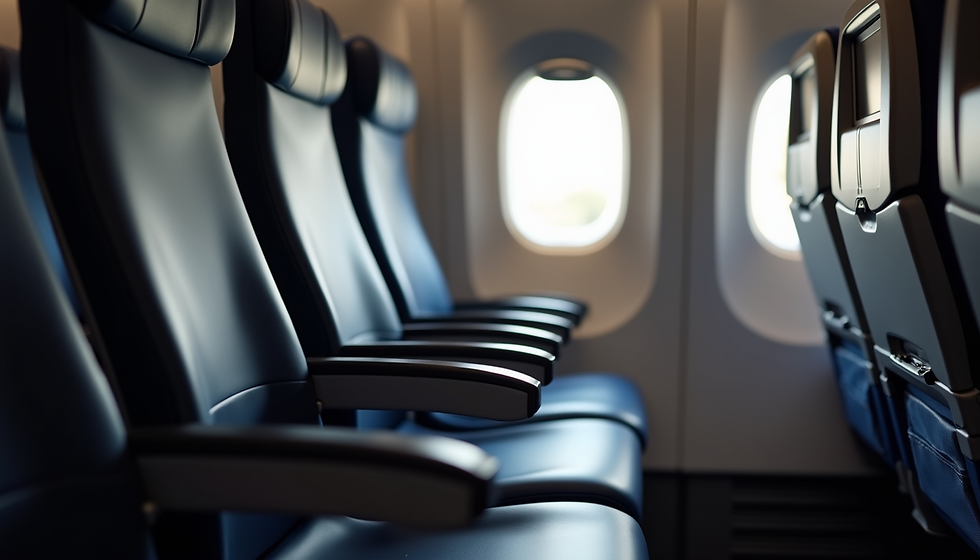What is fear of flying?
- Dr Kristy Potter

- Feb 13
- 4 min read
Updated: Feb 15

For many, flying is an exhilarating experience filled with the promise of new adventures. However, for those with aviophobia (the fear of flying), the experience can trigger a range of psychological and physiological responses that make air travel overwhelming. The fear of flying is not simply a dislike of airplanes; it is a complex psychological experience that manifests in various ways. Understanding these symptoms and their psychological underpinnings is crucial for those looking to manage or overcome their fears.
Common psychological symptoms of fear of flying
Fear of flying often presents as a combination of cognitive, emotional, and behavioural symptoms. These can range from mild unease to severe panic and avoidance.
1. Anxiety and excessive worry
Many individuals with a fear of flying experience intense anxiety well before their flight. This can manifest as:
- Constantly thinking about the potential dangers of flying
- Ruminating on worst-case scenarios, such as a crash or loss of control
- An inability to concentrate on other tasks due to preoccupation with the upcoming flight
2. Panic attacks
Some individuals experience full-blown panic attacks when faced with the prospect of flying or during the flight itself. Symptoms of a panic attack can include:
- Rapid heartbeat
- Shortness of breath
- Dizziness or light-headedness
- Sweating and shaking
- A feeling of impending doom or loss of control
3. Catastrophic thinking
A hallmark of fear of flying is catastrophic thinking, where an individual assumes the worst will happen. This might include:
- Believing that turbulence means the plane is going to crash
- Thinking that every sound or movement is a sign of mechanical failure
- Assuming that personal anxiety will lead to a medical emergency mid-flight
4. Hypervigilance and heightened awareness
People with a fear of flying are often hyper-aware of their surroundings, leading them to overanalyse normal flight sensations. They may:
- Fixate on airplane sounds, assuming any change in noise indicates trouble
- Closely observe flight attendants for signs of concern
- Overreact to minor turbulence, seeing it as a major threat
5. Avoidance behaviours
Avoidance is a key feature of many anxiety disorders, and fear of flying is no exception. Individuals may:
- Avoid booking flights, even when necessary for work or family
- Choose alternative modes of transportation, even when inconvenient
- Cancel travel plans at the last minute due to overwhelming fear
Underlying psychological factors
Fear of flying does not always exist in isolation; it can be tied to deeper psychological mechanisms. Some contributing factors include:
1. Fear of loss of control
Many people who are scared of flying struggle with the idea that they are not in control of the aircraft. Unlike driving a car, where one feels they have control, flying requires complete trust in the pilots and crew.
2. Claustrophobia
The confined space of an airplane cabin can trigger anxiety, especially for those who struggle with claustrophobia. The inability to leave or move freely can increase feelings of panic.
3. Past trauma or negative experiences
A history of bad experiences with flying, such as a turbulent flight or emergency landing, can create lasting fear. Additionally, general trauma unrelated to flying can heighten one’s susceptibility to anxiety in high-stress situations.
4. Media influence and fear conditioning
Media portrayals of plane crashes and aviation disasters can shape irrational fears. Even though flying is statistically one of the safest modes of travel, frequent exposure to dramatic headlines and movies can fuel anxiety.
Managing the psychological impact of fear of flying
While the psychological effects of aviophobia can be overwhelming, they are manageable with the right strategies. Some approaches include:
- Cognitive Behavioural Therapy (CBT): Reframing negative thoughts and learning coping mechanisms; this is the traditional approach for most phobias. It has it’s place, but my clinical experience would suggest that Acceptance and Commitment Therapy (ACT) has been more effective.
- Acceptance and Commitment Therapy (ACT pronounced as a word rather than individual letters); focuses on using values and committed action to focus on the task of flying, using cognitive defusion strategies to help individuals distance themselves from the thoughts / feeling that show up.
- Exposure therapy: Gradual exposure to the flying experience to desensitise fear responses. This can be hard to do for occasional flyers! But we can work around this using various methods like imaginal exposure and use of videos etc. This is often used as part of either CBT or ACT.
- Mindfulness and relaxation techniques: Practicing breathing exercises and mindfulness / meditation to stay calm. This is also a core part of ACT!
- Psychoeducation about aviation: Learning about how planes work and the reality of air safety can help ease anxiety. This is absolutely key, in my experience. I have had direct experience of learning to fly, as well as coming from an aviation family, therefore integrate this into all of my interventions which has had excellent feedback. It should be a key part of any intervention; understanding how the planes stay in the air really helps to ease the anxiety!
What next?
Fear of flying is a real and debilitating psychological issue that affects many people, often having widespread impact on their lives. It can really restrict an individual and families ability to travel and experience life’s adventures. By understanding its cognitive, emotional, and behavioural aspects, individuals can take proactive steps to address their fears. Whether through therapy, mindfulness, or gradual exposure, overcoming aviophobia is possible. The skies are not as frightening as they may seem, and with the right tools, you can learn to navigate them with confidence.







Comments